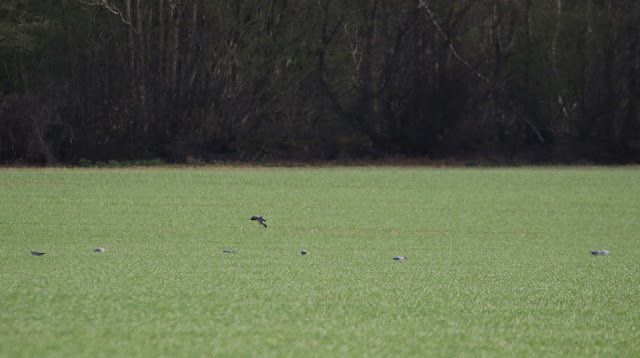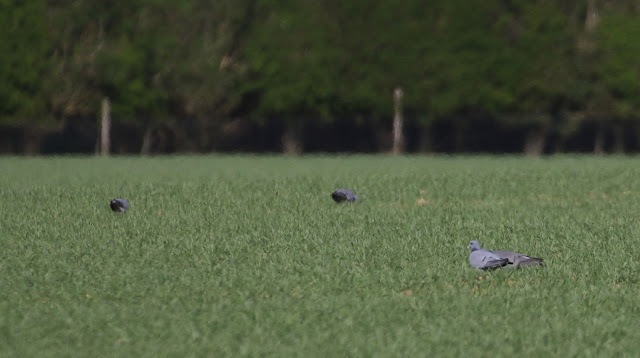The Easter Holiday weekend saw some beautiful weather with the hottest day of the year so far on Good Friday and four days of wall to wall sunshine and glorious azure blue skies. And where was I? Well working in the garden! This though did present some opportunity with two new butterflies for the year making their way across the garden. On the 16th a Holly Blue and on the 18th a male Orange Tip. Neither of course stopped and even if they had of I didn't have a camera close by.
While the temperatures dropped off into the week, the sunshine remained and this provided the opportunity for an afternoon walk. I was hoping for some afternoon butterflies after having seen another Holly Blue in the garden, but they were conspicuous by their absence throughout the walk.
I headed along Brislands Lane and stopped at the junction with Gradwell Lane when I heard a familiar song. It was another Firecrest and showed well in the bushes along the road side.
I thought I would take the opportunity to give some background to the Firecrest. This tiny, restless jewel of a bird vies with the Goldcrest
for the title of the UK's smallest bird. Compared to the Goldcrest, the Firecrest
is brighter and 'cleaner' looking, with a green back, white belly, bronze
'collar' and a black and white eye-stripe. They have a yellow and black stripe
on their heads, which has a bright orange centre in males. Like Goldcrests,
they move through trees and bushes in search of small insects.
A member of the Kinglet family, the Firecrest's scientific
name has a royal ring to it. Regulus ignicapilla translates roughly as the
fire-capped little king, a reference to the beautiful orange crown of the male.
The Firecrest is monogamous. The male sings during the
breeding season, often with its crest raised, and has a display which
involves pointing its bill at another bird, showing the crest and strong face
pattern. This differs from the display of the plainer-faced Goldcrest, which
bows its head to emphasise the crest.
The breeding territory is about 1.2 acres and may overlap
with neighbouring Goldcrest territories. Firecrest will sometimes defend their
territories against Goldcrests with the crest raised and a great deal of
wing-fluttering, but the amount of actual competition between the species
may not be very great.
Unlike more specialised woodland birds which forage on
trunks, the crests do not need large woodlands, and their population density is
independent of forest size. In winter the Firecrest is less reliant on
conifers than the Goldcrest, moving from forest to fringes and scrub. It occurs
singly or in pairs, spending much time in the tree canopy, although frequently
venturing into bushes and other lower vegetation.
The first breeding of Firecrests in the UK was observed in
Hampshire back in 1962. Since then the
species was more likely to be seen on migration, but just recently breeding
numbers have significantly increased. Current figures suggest over 500 breeding
pairs but the likelihood is that this number is far greater. Firecrests thrive in fairly urban areas on
the continent, provided that suitable habitat is available in parks or large
gardens. Locally around Four Marks they
are more likely to be found in gardens, showing a preference to Holly trees
rather than the dense conifers
Leaving the Firecrest I continued out into the open fields away from the houses and gardens. In the field alongside Old Down Wood there was a group of what I thought initially were Woodpigeons, but as they flew I realised they were Stock Dove. I flight I was able to count them, there were 19 in total, by far the highest number I have seen on the patch.
Fortunately the Stock Dove flew around and settled back into the field and I was able to get some records of them, both from the road
And from the path that leads into Old Down Wood.
I took the perimeter path to take in the Bluebells that were now coming through, I would estimate that they are currently at about 50% emerged, the blue haze still entwined with the green. Here is a selection of the best views as I walked around.
One other plant I was looking for was the Early Purple Orchid. As you can see it is yet to flower, but won't be far off.
A Yellowhammer called from the top of the trees on the edge of the wood. It is not usual to see them here so the numbers must be expanding.
While there were a few Blackcaps singing amongst the resident Robins, Wren, Blackbirds and Song Thrushes, the dominant singer was the Chiffchaff. Setting up territories, their songs were essential in letting those that look to move in and take over.
This is the best time of year to photograph them with just the emerging leaves to provide the scenic accessories
This shows very clearly the short primary projection of the Chiffchaff aside from song one of the more reliable ways of telling the Chiffchaff from the closely related Willow Warbler.
It was a pleasant two hour walk, only shame was the sun decided to hide behind clouds and there were no butterflies.


























































